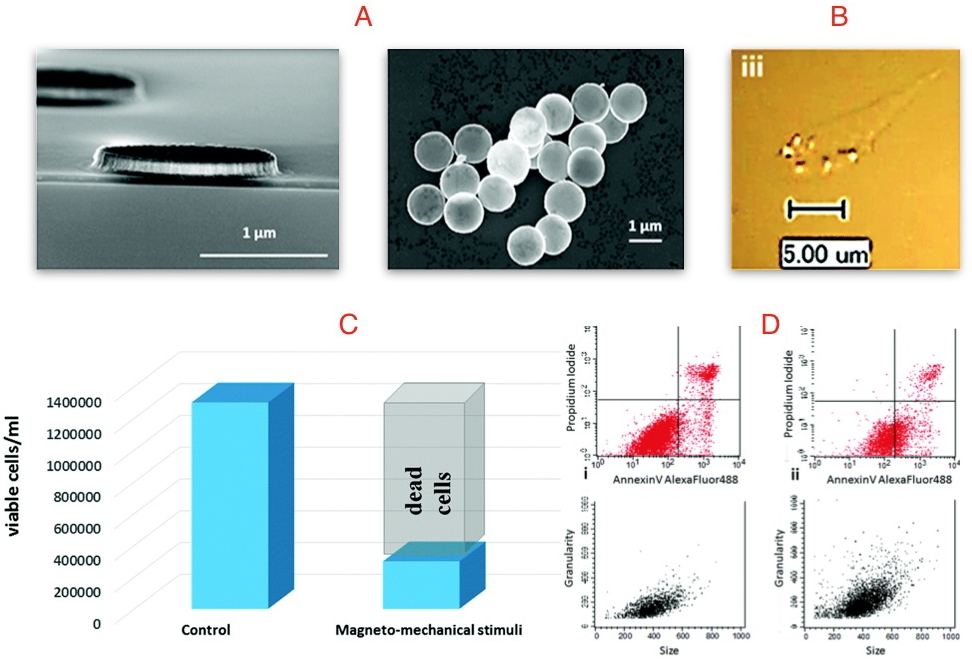A recent approach for cancer cells destruction was proposed, based on the triggering of cancer cell spontaneous death through the mechanical vibration of anisotropic magnetic nanoparticles attached to the cells membrane at low frequencies (20Hz) and in weak magnetic fields (a few mT). The induction of cancer cells apoptosis was demonstrated with NiFe vortex particles and statistically characterized by flow-cytometry, and caspases activation studies.
Magnetic micro/nanoparticles are of great interest in biomedical applications due to the ability that they provide to remotely exert forces on biological species. We demonstrated on human renal carcinoma cells that this can be used to kill cancer cells, work recently published in
Nanoscale. Knowing that at least 20% of humans are expected to face cancer at least once in their live by 2020, this study raises the perspective of a novel approach for cancer therapy, with reduced side effects. This biomedical approach is very different from the widely studied hyperthermia, since it relies on a mechanical effect at low frequency (~20 Hz), and not on a local heating of the cells at high frequency AC fields (hyperthermia: 100 kHz, 10 mT). The particles were prepared by a top-down approach. Different types of particles were prepared and tested with the aim to avoid their agglomeration in solution and to exert strong forces and torques when attached to the cell membrane. NiFe disks in magnetic vortex configuration were selected. They are coated by gold layers to enable their biochemical functionalization (Figure a). The magnetic vortex particles were then bound to the membrane of human renal carcinoma cancer cells through antibody-antigen recognition. For that, the cancer cells line has been transfected for expressing a specific surface antigen, named “human carbonic anhydrase 9” (hCA9), biomarker of tumor hypoxia. The binding of the particles to the cancer cell (Figure b), was achieved by using anti hCA9 antibodies of rabbit. After the treatment based on the application of an AC field of low frequency, a decrease of ~70% in viable cells was observed six hours after the magneto-mechanical stimulus treatment (Figure c). The triggering of the cancer cells apoptosis was then demonstrated by flow cytometry (Figure d). Moreover, microscopic observations showed that activated caspase-3/7 signals, considered as key components of the apoptosis machinery, significantly increases following the treatment. This study will now be pursued in collaboration with Clinatec towards
in vivo experiments and hopefully in the longer term of a practical cancer treatment.
This multidisciplinary study is the result of a collaboration between SPINTEC, SPrAM/CREAB, SCIB/LAN, THEREX/CHU, SP2M/NM, and the use of the clean room PTA.
Acknowledgement: This work was partially supported by Agence Nationale de la Recherche via the P2N grant Nano-Shark reference ANR-11-NANO-001 and funding for this project was partially provided by a grant CIBLE 2012 from La Région Rhône-Alpes..

a) NiFe vortex particles ∅1µm.
b) Cancer cell to which six functionalized particles are bound.
c) Cell remaining alive proportion, trepan blue staining.
d) Flow cytometry analysis of annexine V and propidium iodide staining.